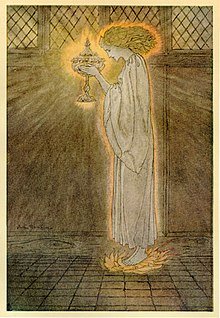The legend of the Holy Grail is one of the most enduring in Western European literature and art. The Grail was said to be the cup of the Last Supper and at the Crucifixion to have received blood flowing from Christ's side. It was brought to Britain by Joseph of Arimathea, where it lay hidden for centuries.
The search for the vessel became the principal quest of the knights of King Arthur. It was believed to be kept in a mysterious castle surrounded by a wasteland and guarded by a custodian called the Fisher King, who suffered from a wound that would not heal. His recovery and the renewal of the blighted lands depended upon the successful completion of the quest. Equally, the self-realisation of the questing knight was assured by finding the Grail. The magical properties attributed to the Holy Grail have been plausibly traced to the magic vessels of Celtic myth that satisfied the tastes and needs of all who ate and drank from them.
The Holy Grail first appears in a written text in Chrétien de Troyes's Old French verse romance, the Conte del Graal ('Story of the Grail'), or Perceval, of c.1180. During the next 50 years several works, both in verse and prose, were written although the story, and the principal character, vary from one work to another. In France this process culminated in a cycle of five prose romances telling the history of the Grail from the Crucifixion to the death of Arthur. The Old French romances were translated into other European languages. Among these other versions two stand out: Wolfram von Eschenbach's Parzifal (early 13th century) and Sir Thomas Malory's Morte Darthur (late 15th century).
With the passing of the Middle Ages, the Grail disappears until the 19th century when medieval history and legend awoke the interest of writers such as Scott and Tennyson, of the artists of the Pre-Raphaelite Brotherhood, and of composers, notably Richard Wagner. The symbol of the Grail as a mysterious object of search and as the source of the ultimate mystical, or even physical, experience has persisted into the present century in the novels of Charles Williams, C.S. Lewis and John Cowper Powys.
 Source: http://www.bl.uk/onlinegallery/features/mythical/grail.html
Source: http://www.bl.uk/onlinegallery/features/mythical/grail.html
Hi! I am a robot. I just upvoted you! I found similar content that readers might be interested in:
http://www.bl.uk/onlinegallery/features/mythical/grail.html
Congratulations @tifelove! You have completed some achievement on Steemit and have been rewarded with new badge(s) :
Click on any badge to view your own Board of Honor on SteemitBoard.
For more information about SteemitBoard, click here
If you no longer want to receive notifications, reply to this comment with the word
STOPCongratulations @tifelove! You have received a personal award!
Click on the badge to view your Board of Honor.
Do not miss the last post from @steemitboard:
Congratulations @tifelove! You received a personal award!
You can view your badges on your Steem Board and compare to others on the Steem Ranking
Vote for @Steemitboard as a witness to get one more award and increased upvotes!